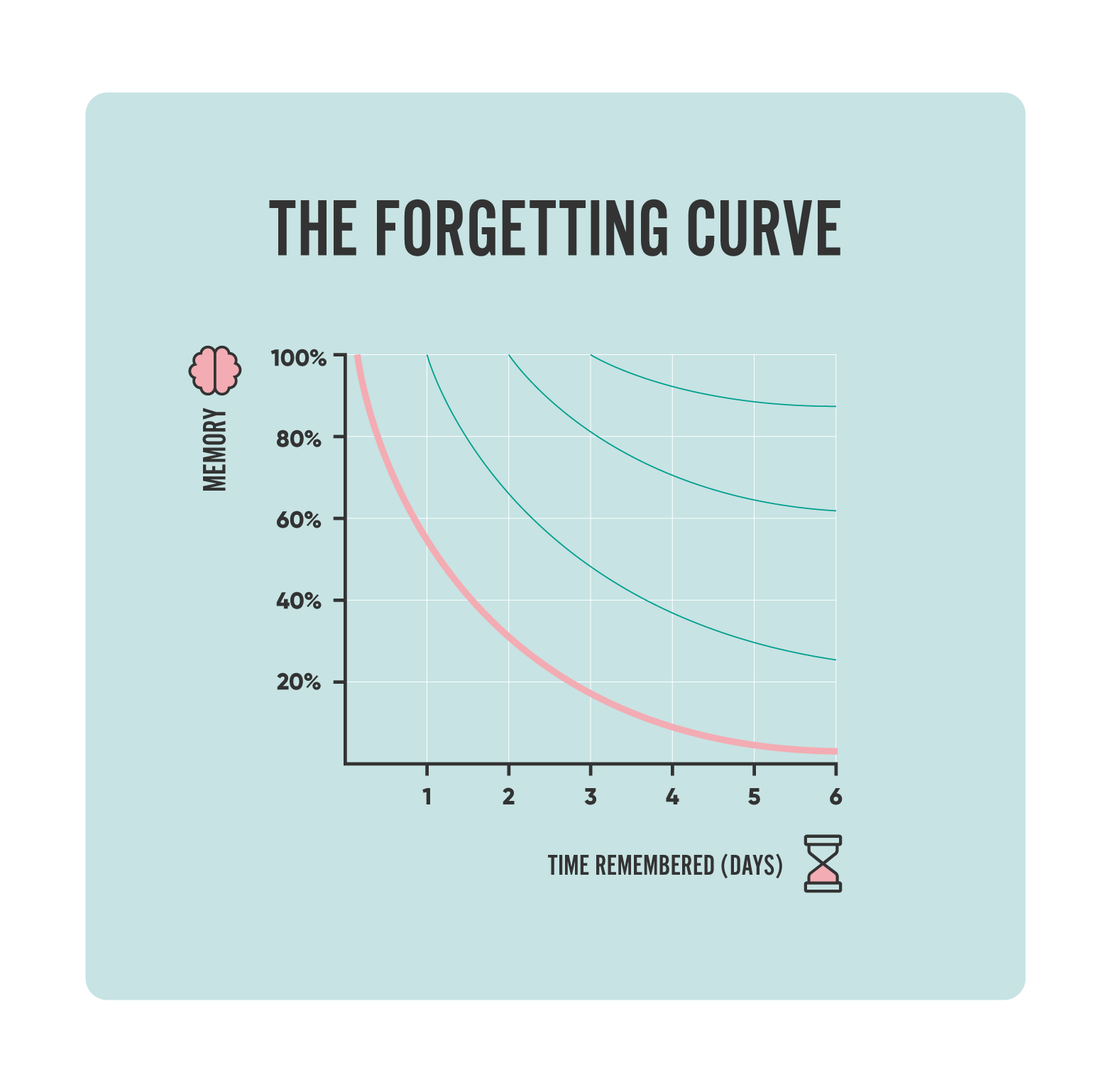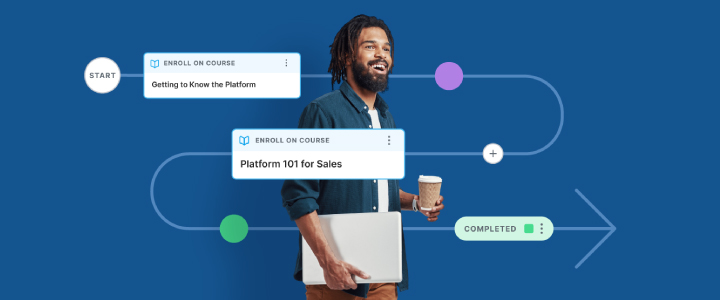
5 min reading time
5 Ways to Challenge the Forgetting Curve
How often have you taken an online course and remembered every piece of information you consumed immediately afterward? Probably never. That’s down to the Ebbinghaus forgetting curve.
Ebbinghaus’ forgetting curve shows how quickly we forget information over time if we make no attempt to retain it. For learning and development professionals, this presents an obvious challenge. Is there any point in investing time and money in course creation and training, if learners are unlikely to retain the information they’ve gained?
To tackle this challenge you need to understand what the forgetting curve is, and more importantly, the impactful tactics you can use to overcome it.
What is the Ebbinghaus forgetting curve?
You’re probably more familiar with the forgetting curve than you think, with the effects being felt in everyday life, not just in eLearning.
Let’s look at an example; you’re at a networking event and a potential customer gives you their contact number which you write down on a piece of paper. If you lost that piece of paper, would you remember the phone number an hour later? Probably not.
Before we try to combat the forgetting curve in eLearning, let’s explain exactly what it is.
The forgetting curve is a mathematical formula by Hermann Ebbinghaus that originated in 1885. The curve demonstrated the rate at which information is forgotten over time if we don’t attempt to retain it.
Learners will rapidly lose their memory of learned knowledge in a matter of days or weeks unless the information is consciously reviewed. Some studies suggest that humans forget approx 50% of new information within an hour of learning it. That goes up to an average of 70% within 24 hours.

However, the rate at which a person forgets depends on several factors including memory strength, how meaningful the material is, and physiological factors such as stress. The good news is that there are a number of methods you can use in your courses to help your learners challenge the forgetting curve.
1. Spaced learning
To thoroughly understand what is learned, there are two important elements to consider. One is time. And the other is the application of repetition.
This can be achieved with spaced learning, which is why it’s considered one of the best methods for combating the learning curve. Spaced learning helps learners manage what learned information is retained, enabling them to reshape the forgetting curve. In turn, spaced learning benefits organizations as it supports the retention of skills and increased productivity in the long-term.
So, what exactly is spaced learning? Well, it’s a learning methodology where learners are presented with material they have to learn in a timed session, with a short break provided after they’ve completed it. Spaced learning strengthens memory retention because the learner studies the information, and periodically returns to review it in order to retain the knowledge.
The learner also practices retrieving the learned information using different formats such as solving problems, completing exams, and so on. This reinforces what has been learned, battling the forgetting curve.
Spaced learning can be tailored to suit your eLearning needs. The spacing can occur within a single course module, or by scheduling modules and courses several hours, days, or weeks apart. By using bite-sized chunks of content and demonstrating the required information repeatedly in different, creative ways, like blended learning, learners are more likely to absorb the information.
2. Make it accessible
If you want your training content to stick, making access to courses convenient for your learners is crucial. They should have the ability to complete training wherever they are, at any time of the day.
This is where mobile learning, or mLearning, comes into play. Ensuring your LMS is mobile responsive makes learning and retaining information easier for your learners. They’ll have a much better chance of recollecting and refreshing their knowledge if they can access their courses when and where they like; on the bus to work, or while waiting on a client for a lunch meeting.
3. Keep it engaging
Having engaging courses will not only improve completion rates, but it also helps learners to retain information. So, when planning out course content, keep the forgetting curve top of mind. But how can you achieve this?
We suggest you make information easier to digest from the get-go. Learner concentration naturally wanes if they’re reading mountains of text, reducing knowledge retention. Instead, mix things up and keep your learners interest by varying the content you’re using with videos, images, and webinars. Even better, go the extra mile by having your learners actively participate in the course, rather than being passive observers.
Gamification is another option for using engagement to beat the forgetting curve.. It takes the mechanics of games and applies them to other activities, like eLearning, which can then be used to motivate your learners to complete the required learning. And, because it’s interactive and gets your learners engaged, knowledge retention is more likely.
4. Create a learning culture
Learners are more likely to prioritize training, and retain relevant knowledge, if you create a learning culture within your organization. Whether it’s formal learning delivered through an LMS or informal learning through knowledge sharing at the water cooler, learning is always happening.
If your company carries out mandatory isolated training events every now and then, the forgetting curve will probably get the better of your learners. Creating an open learning environment doesn’t have to be difficult. By running frequent training events, you’ll help reinforce learning and increase the amount of knowledge that’s retained. Encourage learners to share their feedback after completing a course, and use this information to both improve your content and nurture a positive learning culture.
From a practical point of view, you can encourage your learners to embrace this learning culture by making it as enjoyable as possible for them. You can achieve this by creating engaging course content with a great UX, and delivering it to your learners through an easy to use LMS.
Actively support knowledge sharing within your organization, whether it’s through training days, workshops, or a thorough onboarding process. Once your learners recognize that frequent learning and reiteration is part of your organization’s daily routine, they’re more likely to engage in training and retain pertinent knowledge.
5. Make it relevant
The human brain is selective and has a limited capacity. When it comes to deciding whether to store particular pieces of information permanently, the brain can be quite choosy. And, this naturally accelerates the forgetting curve. That’s why, when planning training, you should make it as relevant to the learner as possible. The more relevant the training, the easier it will be for them to absorb and remember the information they need.
By relevant, we’re not talking about using pop culture references, we mean relevant to their job. If they know that learning something will make their job easier, or save them time, they’re more likely to accept and remember the training. The more applicable to their daily tasks the information is, the more meaningful the learning experience becomes.
So, how can you apply this to your training programs? Make the course content relevant to your learners’ job function or role by including examples or scenarios that they experience every day. If you want learners to know new information or gain advanced skills, try to relate the training to information your learners already know. If the training solves pain points learners have, make sure they know that completing this training will help them.
Now that you have 5 implementable tips for challenging the forgetting curve, you’ll need a great LMS to apply them. Your LMS should enable you to carry out creative repetition through various mediums, in addition to supporting blended learning, spaced learning, mLearning, and gamification.



